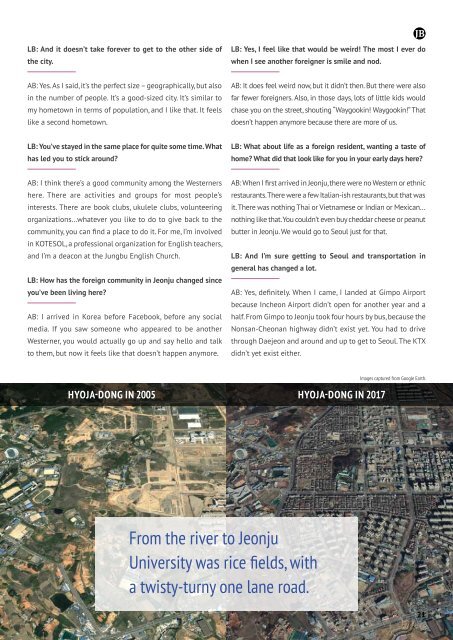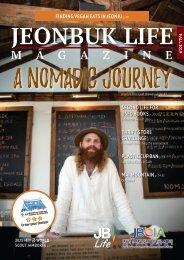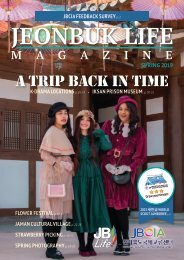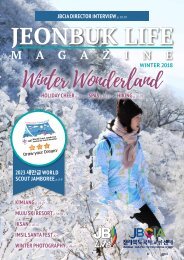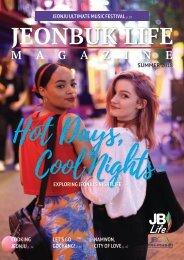Create successful ePaper yourself
Turn your PDF publications into a flip-book with our unique Google optimized e-Paper software.
LB: And it doesn’t take forever to get to the other side of<br />
the city.<br />
LB: Yes, I feel like that would be weird! The most I ever do<br />
when I see another foreigner is smile and nod.<br />
AB: Yes. As I said, it’s the perfect size – geographically, but also<br />
in the number of people. It’s a good-sized city. It’s similar to<br />
my hometown in terms of population, and I like that. It feels<br />
like a second hometown.<br />
AB: It does feel weird now, but it didn’t then. But there were also<br />
far fewer foreigners. Also, in those days, lots of little kids would<br />
chase you on the street, shouting “Waygookin! Waygookin!” That<br />
doesn’t happen anymore because there are more of us.<br />
LB: You’ve stayed in the same place for quite some time. What<br />
has led you to stick around?<br />
LB: What about life as a foreign resident, wanting a taste of<br />
home? What did that look like for you in your early days here?<br />
AB: I think there’s a good community among the Westerners<br />
here. There are activities and groups for most people’s<br />
interests. There are book clubs, ukulele clubs, volunteering<br />
organizations…whatever you like to do to give back to the<br />
community, you can find a place to do it. For me, I’m involved<br />
in KOTESOL, a professional organization for English teachers,<br />
and I’m a deacon at the Jungbu English Church.<br />
LB: How has the foreign community in Jeonju changed since<br />
you’ve been living here?<br />
AB: I arrived in Korea before Facebook, before any social<br />
media. If you saw someone who appeared to be another<br />
Westerner, you would actually go up and say hello and talk<br />
to them, but now it feels like that doesn’t happen anymore.<br />
AB: When I first arrived in Jeonju, there were no Western or ethnic<br />
restaurants. There were a few Italian-ish restaurants, but that was<br />
it. There was nothing Thai or Vietnamese or Indian or Mexican…<br />
nothing like that. You couldn’t even buy cheddar cheese or peanut<br />
butter in Jeonju. We would go to Seoul just for that.<br />
LB: And I’m sure getting to Seoul and transportation in<br />
general has changed a lot.<br />
AB: Yes, definitely. When I came, I landed at Gimpo Airport<br />
because Incheon Airport didn’t open for another year and a<br />
half. From Gimpo to Jeonju took four hours by bus, because the<br />
Nonsan-Cheonan highway didn’t exist yet. You had to drive<br />
through Daejeon and around and up to get to Seoul. The KTX<br />
didn’t yet exist either.<br />
Hyoja-Dong in 2005 Hyoja-Dong in 2017<br />
Images captured from Google Earth.<br />
From the river to Jeonju<br />
University was rice fields, with<br />
a twisty-turny one lane road.<br />
21


